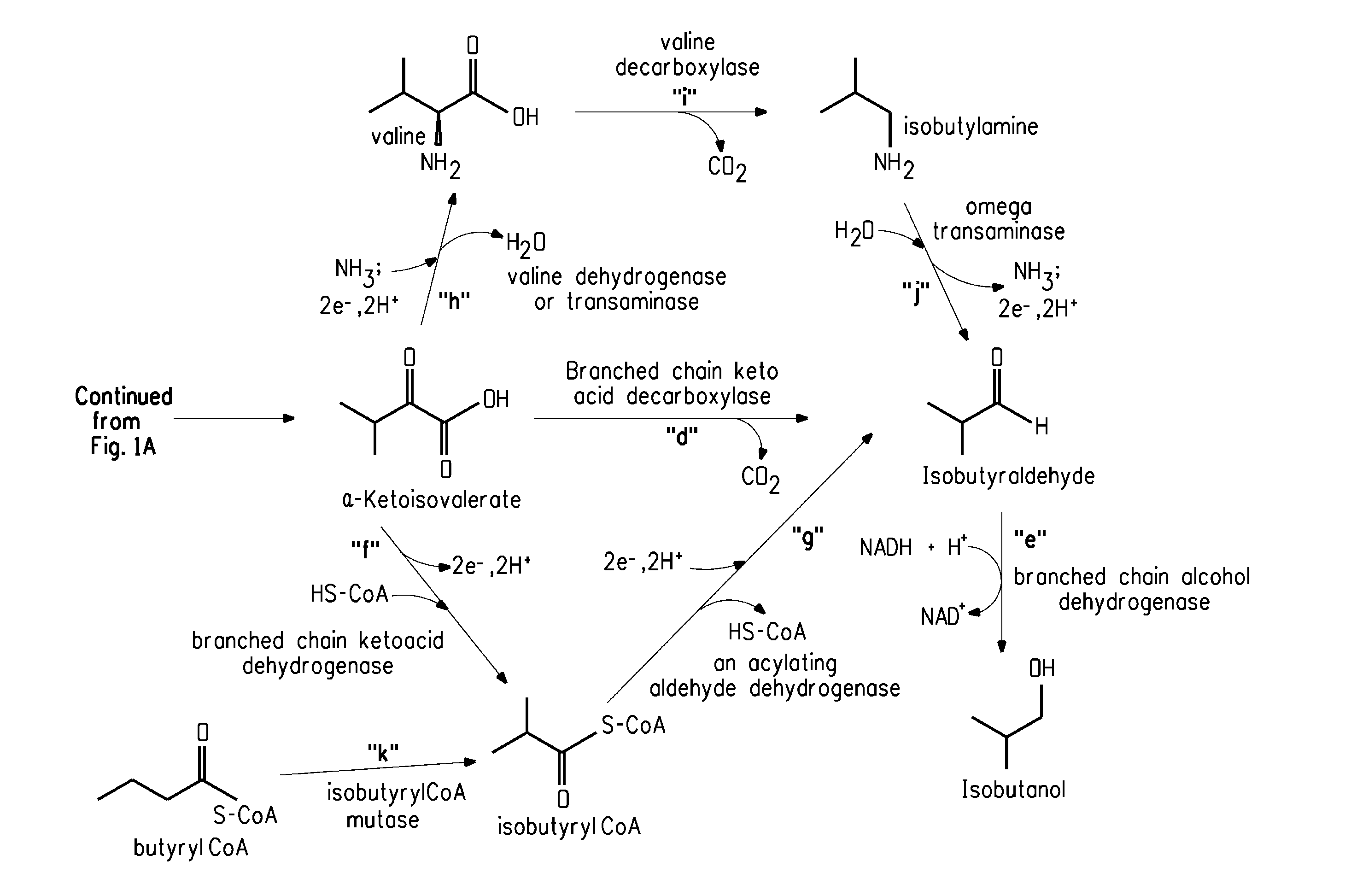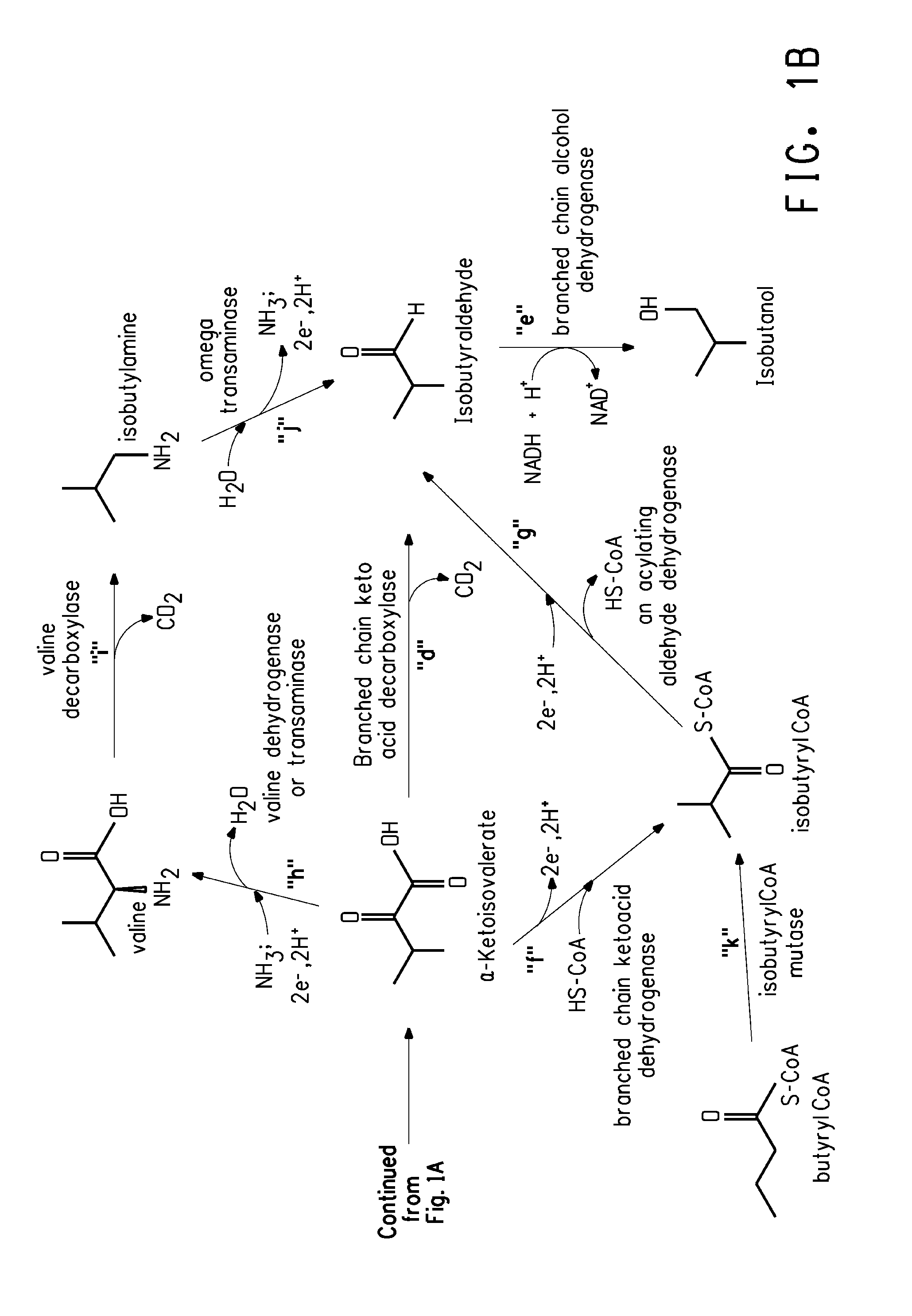Fermentive production of isobutanol using highly active ketol-acid reductoisomerase enzymes
a reductoisomerase enzyme, highly active technology, applied in the direction of biofuels, microorganisms, biochemical equipment and processes, etc., can solve the problems of low yield of fusel oil and/or its components during beverage fermentation, and inability to meet the requirements of industrial scale isobutanol production
- Summary
- Abstract
- Description
- Claims
- Application Information
AI Technical Summary
Problems solved by technology
Method used
Image
Examples
example 1
Comparative
Analysis of KARI Enzyme Activity
[0174]This example describes preparation of ilvC gene over-expression constructs and measurement of enzyme activity using the acetolactate dependent oxidation of NADPH by the KARI enzyme encoded by the ilvC gene of E. coli.
Construction of pBAD-ilvC Expression Plasmid—Isolation of the ilvC Gene from E. coli
[0175]The ilvC gene coding region was amplified from E. coli strain FM5 (ATCC 53911) genomic DNA using PCR. The cells were grown overnight (37° C., while shaking at 300 RPM) in 50 mL culture tubes containing 4 mL of Luria Bertani (LB) medium (Mediatech Inc., Herndon, Va.). They were then harvested by centrifugation at 1000×g for 3 min and genomic DNA of the cells was prepared using the Gentra Puregene kit (Gentra Systems, Inc., Minneapolis, Minn.; catalog number D-5000A) according to the manufacturer's directions. An ilvC coding region DNA fragment was prepared by PCR using the E. coli DNA as template and primers SEQ ID No: 11 and 12.
[01...
example 2
Identification of KARI with High Specific Activity Enzyme from Various Microorganisms
[0196]The purpose of this Example is to describe how to identify microorganisms that contain KARI enzymes with high specific activity.
[0197]It was hypothesized that those KARI-containing organisms with faster doubling times than E. coli, during growth in a minimal medium, will contain highly active KARI enzymes. Three microorganisms, Pseudomonas aeruginosa (PAO1), Pseudomonas fluorescens (PF5), and Vibrio cholerae (N16961), were identified with faster doubling times than E. coli when grown in the M9 minimal medium (See below). Genomic DNA preparations of these organisms are commercially available. Table 5 shows the doubling times of these organisms compared to E. coli following growth in the minimal M9 medium.
TABLE 5DOUBLING TIMES OF STRAINS TESTED DURINGGROWTH IN THE M9 MEDIUMDoubling time in M9OrganismmediumReferenceE. coli55-60 min 1V. cholerae (N16961)45 min3P. aeruginosa (PAO1)42 min2P. fluore...
example 3
Analysis of Specific Activity of Purified K12-KARI and the PF5-KARI
[0206]To better resolve increases in KARI specific activity observed with crude cell extracts in Example 2, K12-KARI and PF5-KARI were purified to homogeneity to allow accurate quantification of the concentration of individual proteins and determine specific activity of the purified KARI enzymes.
Purification of K12-KARI and PF5-KARI
[0207]Both K12-KARI and PF5-KARI were purified using the weak anion-exchange spin column, Vivapure IEX D, miniH (Vivascience A G, Hannover, Germany), followed by concentration in a Microcon device with 100 KDa molecular weight cutoff (YM100, Millpore, Bedford, Mass.). The purification procedure was carried out at room temperature (22.5° C.).
[0208]Stock solutions used in the anion-exchange spin column were: 100 mM potassium-HEPES at pH 7.0, 1.0 M MgCl2, 250 mM EDTA, 10% Brij35 and 2 M KCl. Wash buffer (BufferA) was made by adding 5.0 mL of 100 mM HEPES stock to 15 mL water with the addition...
PUM
| Property | Measurement | Unit |
|---|---|---|
| Temperature | aaaaa | aaaaa |
| Fraction | aaaaa | aaaaa |
| Molar density | aaaaa | aaaaa |
Abstract
Description
Claims
Application Information
 Login to View More
Login to View More - R&D
- Intellectual Property
- Life Sciences
- Materials
- Tech Scout
- Unparalleled Data Quality
- Higher Quality Content
- 60% Fewer Hallucinations
Browse by: Latest US Patents, China's latest patents, Technical Efficacy Thesaurus, Application Domain, Technology Topic, Popular Technical Reports.
© 2025 PatSnap. All rights reserved.Legal|Privacy policy|Modern Slavery Act Transparency Statement|Sitemap|About US| Contact US: help@patsnap.com



